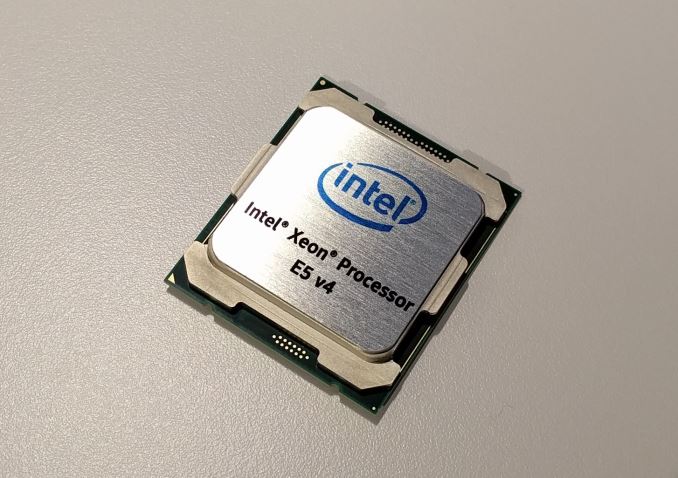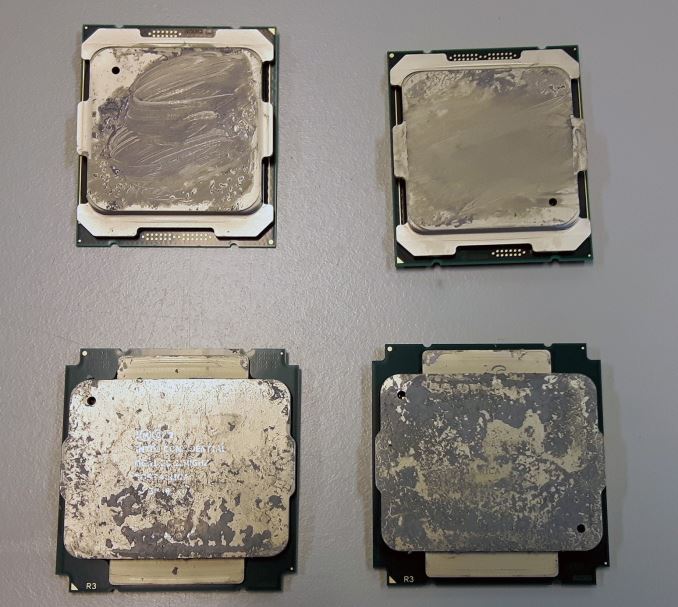The Intel Xeon E5 v4 Review: Testing Broadwell-EP With Demanding Server Workloads
by Johan De Gelas on March 31, 2016 12:30 PM EST- Posted in
- CPUs
- Intel
- Xeon
- Enterprise
- Enterprise CPUs
- Broadwell

We have been spoiled. Since the introduction of the Xeon "Nehalem" 5500 (Xeon 5500, March 2009), Intel has been increasing the core counts of their Xeon CPUs by nearly 50% almost every 18 months. We went from four to six (Xeon 5600) on June 2010. Sandy Bridge (Xeon E5-2600, March 2012) increased the core count to 8. That is only 33% more cores, but each core was substantially faster than the previous generation. Ivy Bridge EP (Xeon E5-2600 v2, launched September 2013) increased the core count from 8 to 12, the Haswell-EP (Xeon E5-2600 v3, sept 2014) surprised with an 18-core flagship SKU.
However it could not go on forever. Sooner or later Intel would need to slow down a bit on adding cores, for both power and space reasons, and today Intel has finally pumped the brakes a bit.
Launching today is the latest generation of Intel's Xeon E5 processors, the Xeon E5 v4 series.Fifteen months after Intel's Broadwell architecture and 14nm process first reached consumers, Broadwell has finally reached the multi-socket server space with Broadwell-EP. Like past EP cores, Broadwell-EP is the bigger, badder sibling of the consumer Broadwell parts, offering more cores, more memory bandwidth, more cache, and more server-focused features. And thanks to the jump from their 22nm process to their current-generation 14nm process, Intel gets to reap the benefits of a smaller, denser process.
Getting back to our discussion of core counts then, even with the jump to 14nm, Intel has played it more conservatively with their core counts. Compared to the Xeon E5 v3 (Haswell-EP), Xeon E5 v4 (Broadwell-EP) makes a smaller jump, going from 18 cores to 24 cores, for an increase of 33%. Yet even then, for the new Xeon E5 v4 "only" 22 cores are activated, so we won't get to see everything Broadwell-EP is capable of right away.
Meanwhile the highest (turbo) clockspeed is still 3.6 GHz, base clocks are reduced with one or two steps and the core improvements are very modest (+5%). Consequently, performance wise, this is probably the least spectacular product refresh we have seen in many years.
But there are still enough paper specs that make the Broadwell version of the Xeon E5 attractive. It finds a home in the same LGA 2011-3 socket. Few people will in-place upgrade from Xeon E5 v3s to Xeon E5 v4s, but using the same platform means less costs for the server vendors, and more software maturity (drivers etc.) for the buyers.

They look very different but fit in the same socket: Xeon E5 v4 on top, Xeon E5 v3 at the bottom
Broadwell also has several features that make it a more attractive processor for virtualized servers. Finer granular control over how applications share the uncore (caches and memory bandwidth) to avoid scenarios where low priority applications slow down high priority ones. Meanwhile quite a few improvements have been made to make the I/O intensive applications run smoother on top of a virtualized layer. Most businesses run their applications virtualized and virtualization is still the key ingredient of the fast growing cloud services (Amazon, Digital Ocean, Azure...), and more and more telecom operators are starting to virtualized their services, so these new features will definitely be put to good use. And of course, Intel made quite a few subtle - but worth talking about - tweaks to keep the HPC (mostly "simulation" and "scientific calculation software) crowd happy.
But don't make the mistake to think that only virtualization and HPC are the only candidates for the new up-to-22-cores Xeons. The newest generation of data analytics frameworks have made enormous performance steps forward by widening the network and storage bandwidth bottlenecks. One example is Apache Spark, which can crunch through terabytes of data much more efficiently than its grandparent Hadoop by making better use of RAM. To get results out of a massive hump of text data, for example, you can use some of most advanced statistical and machine learning algorithms. Mix machine learning with data mining and you get an application that is incredibly CPU-hungry but does not need the latest and fastest NVMe-based SSDs to keep the CPU busy.
Yes, we are proud to present our new benchmark based upon Apache Spark in this review. Combining analytics software with machine learning to get deeper insights is one of the most exciting trends in the enterprise world. And it is also one of the reason why even a 22-core Broadwell is still not fast enough.










112 Comments
View All Comments
PowerOfFacts - Thursday, June 23, 2016 - link
And now Oracle marketing speaks. Their HammerDB results are bogus. Oracle continues to site socket results when the majority of the world has moved on to per core results. They cite the results from a 32 core HammerDB then compare it to a 1 chip (1/2 of 1 socket) POWER8 because Phil has a hard-on for how "HE" believes IBM has packaged the processor and similarly chooses an Intel configuration to ensure "THEY" get the result they want. Phil & Oracle (appear) to always speak with forked tongue.patrickjp93 - Sunday, April 3, 2016 - link
"Best" only at specific scale-up workloads. There's a reason Sparc is not particularly popular for clusters and supercomputing (and it's NOT software compatibility). It sucks at a lot of workloads when compared to x86. As for the SAP benchmarks, that's to be expected since x86 doesn't yet support transactional memories. That changes with Skylake Purley though.Brutalizer - Wednesday, April 6, 2016 - link
In these 25ish benchmarks, the SPARC M7 is 2-3x faster on all kinds of workloads, not just some specific scale up workloads. The reason SPARC M7 is not popular for clusters (supercomputers are clusters) is not because of low raw compute performance, it is because of cost and wattage. The M7 is much more expensive than x86, and draws much more power. I guess somewhere 250 watt or so? M7 are in big enterprise servers, some have water cooling, etc. Whereas clusters have many cheap nodes, with no water cooling.Clusters can have x86 because the highest wattage x86 cpu, uses 140 watt or so. Not more. So it would be feasible to use 140 watt cpus in clusters. But not 250 watt cpus, they draw too much power.
For instance, the IBM Blue Gene supercomputer that hold spot nr 5 in top500 for a couple of years, used 850 MHz powerpc cpus, when everyone else used 2.4 GHz x86 or so. The 850 MHz cpu dont use lot of power, so that is the reason it was used in Blue Gene, not because it was faster (it wasnt). A large supercomputer can draw 10 MegaWatt, and that costs very much. Power is a huge issue in super computers. SPARC M7 draws too much power to be useful in a large cluster, and costs too much.
If we talk about raw compute power for SPARC M7, it reaches 1200 SPECint2006, whereas E5-2699v3 reaches 715 SPECint2006. Not really 2-3x faster, but still much faster.
In SPECfp2006, the M7 reaches 832, whereas the E5-2699v3 reach 474.
https://blogs.oracle.com/BestPerf/entry/201510_spe...
So, as you can see yourself, the SPARC M7 is faster on scale-up business workloads (it was designed for that type of workloads) and also faster on raw compute power. And faster in everything in between. Just look at the wide diversity among these 25 ish benchmarks.
Brutalizer - Wednesday, April 6, 2016 - link
BTW, do you really expect a 150 watt x86 cpu, to outperform a 250 watt SPARC M7 cpu? Have you seen benchmarks where they compare 250 watt graphics card vs a 150 watt graphics card? Which GPU do you think is faster? Do you expect a 150 watt GPU to outperform a 250 watt gpu?The SPARC M7 has 50% more cores, twice the cpu cache, twice the GHz, twice the Wattage, twice the RAM bandwidth, twice the nr of transistors (10 billions) - and you are surprised it is 2-3x faster than x86?
BTW, the SPARC M7 has stronger cores than x86. If you look at all these benchmarks, typically one M7 with 32 cores, is faster than two E5-2699v3 with 2x18 = 36 cores. This must mean that one SPARC M7 core, packs more punch than a E5-2699v3 core, because 32 SPARC cores are faster than 36 x86 cores in all benchmarks.
adamod - Friday, June 3, 2016 - link
i know this is an old post but i am confused (this isnt something i have learned much about yet) i am hoping you can help some...if the sparc has 2 to 3x performance and is 250w compared to 140w then wouldnt that make it MORE efficient? and if you need two 2699's to compare to a sparc m7 then wouldnt that be 280w, more than the 250w of the xeons? i realize there are other factors here but this doesnt make sense to me. also yea there are graphics cards that are a lower wattage and perform better...i am an AMD fan but nvidia has had some faster cards with better performance in the past...i have an R9 280X, a mid grade card rated at i believe 225w, kinda crazy when it can get beaten by 17w nvidia cardstqth - Sunday, April 3, 2016 - link
The SPARC and POWER servers are for people with unlimited pocket where compactness and reliability worth the premium it's spent on. If you have to ask how much it costs, you'd probably can't afford it.Xeons are commodity hardware where you could purchase the best bang for your buck.
They are not aiming at the same market. Most software wouldn't even work on both system.
Besides, benchmarks are worthless - unless the performance of the specific software is tested. And that's rare.
PowerOfFacts - Thursday, June 23, 2016 - link
Depends on which Xeon processors you are referring to. The latest Broadwell EP & EX chips can cost over $7K each. Well on par if not exceeding POWER8 chips and definitely more than OpenPOWER chips. Times are changing. Intel has milked their clients for a long time feeding them the marketing line of open, commodity & low cost. They are no longer open buying up ecosystem integrating into the silicone, what exactly does commodity mean anyway and as low cost goes ... as I just said, pretty salty.yuhong - Thursday, March 31, 2016 - link
64GB LR-DIMMs will probably not come out at reasonable prices until 8Gbit DDR4 is more mainstream.iwod - Thursday, March 31, 2016 - link
I thought Samsung announced a 128GB DIMM with some type of 3D / TSV RAM.Casper42 - Thursday, March 31, 2016 - link
Not shipping just yet though.Should be sometime this year though.